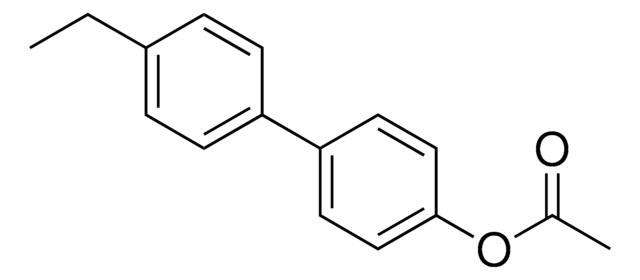推荐产品
一般描述
应用
4-Biphenylacetic acid was used in the synthesis of gastrosparing non-steroidal antiinflammatory drug[3].
警示用语:
Danger
危险分类
Acute Tox. 3 Inhalation - Acute Tox. 3 Oral - Eye Irrit. 2 - Skin Irrit. 2 - STOT SE 3
靶器官
Respiratory system
储存分类代码
6.1C - Combustible acute toxic Cat.3 / toxic compounds or compounds which causing chronic effects
WGK
WGK 3
闪点(°F)
Not applicable
闪点(°C)
Not applicable
个人防护装备
Eyeshields, Faceshields, Gloves, type P2 (EN 143) respirator cartridges
I Smolders et al.
Antimicrobial agents and chemotherapy, 46(2), 471-477 (2002-01-18)
Fluoroquinolones are antibiotics with central excitatory side effects. These adverse effects presumably result from inhibition of gamma-aminobutyric acid (GABA) binding to GABA(A) receptors. This GABA antagonistic effect is greatly potentiated by the active metabolite of fenbufen, biphenylacetic acid (BPAA). Nevertheless
H Arima et al.
European journal of pharmaceutical sciences : official journal of the European Federation for Pharmaceutical Sciences, 6(1), 53-59 (2005-11-01)
The effect of hydroxypropyl-beta-cyclodextrin (HP-beta-CyD) on the cutaneous penetration and activation of ethyl 4-biphenylyl acetate (EBA), a prodrug of non-steroidal anti-inflammatory drug 4-biphenylylacetic acid (BPAA), from hydrophilic ointment was investigated, using hairless mouse skin in vitro. When the hydrophilic ointment
Yohei Sakaguchi et al.
Journal of pharmaceutical and biomedical analysis, 55(1), 176-180 (2011-02-12)
Fluorous derivatization followed by fluorous-phase liquid chromatographic (LC) separation exploits the affinity between perfluoroalkyl compounds for highly selective and quantitative isolation of various analytes. However, the applicability of this technique as a simple pretreatment for fluorometric determination in clinical settings
Takako Ishiguro et al.
International journal of pharmaceutics, 419(1-2), 161-169 (2011-08-16)
2-Hydroxybutyl-β-cyclodextrins (HB-β-CyDs) with different degrees of substitution (D.S.) were prepared and their physicochemical and biological properties and solubilizing abilities were studied and compared with those of 2-hydroxypropyl-β-cyclodextrin (HP-β-CyD). The surface activity of HB-β-CyD was higher than that of HP-β-CyD (D.S.
A I Khan et al.
Chemical communications (Cambridge, England), (22)(22), 2342-2343 (2002-09-21)
A series of pharmaceutically active compounds including diclofenac, gemfibrozil, ibuprofen, naproxen, 2-propylpentanoic acid, 4-biphenylacetic acid and tolfenamic acid can be reversibly intercalated into a layered double hydroxide, initial studies suggest that these materials may have application as the basis of
Active Filters
我们的科学家团队拥有各种研究领域经验,包括生命科学、材料科学、化学合成、色谱、分析及许多其他领域.
联系客户支持







![2-[2-(2-氯乙氧基)乙氧基]乙醇 96%](/deepweb/assets/sigmaaldrich/product/structures/902/295/ff6d7bb1-a7e0-4582-86e1-819084626e67/640/ff6d7bb1-a7e0-4582-86e1-819084626e67.png)

